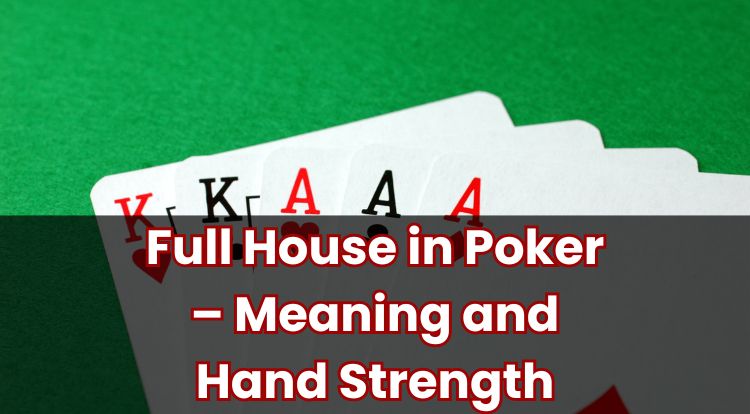What Is Short Deck Poker? Rules & Hand Rankings
Poker comes in many different forms, each with its own set of rules and strategies. One version that has gained attention is Short Deck Poker, also known as Six Plus Hold’em. This game uses a smaller deck, which changes the way hands are ranked and affects how often certain combinations appear.
This blog will explain what Short Deck Poker is, how it differs from other types of poker, and the rules you need to know before playing. You’ll also find a breakdown of hand rankings, as they are different from those used in traditional poker games. If you’re new to this variation, understanding these differences can help you follow the game more easily.
Like all forms of poker, Short Deck Poker involves an element of chance, so outcomes are never certain. If you’re interested in learning more about how this version works, keep reading to find out what makes it unique.
What Is Short Deck Poker?
Poker has many different versions, each with its own set of rules. One lesser-known variation is Short Deck Poker. This version follows a similar structure to Texas Hold’em, but with a key difference—the deck is smaller.
Short Deck Poker is played with a 36-card deck instead of the standard 52-card deck. The 2s, 3s, 4s, and 5s are removed, leaving only 6s through to aces. This change impacts the probability of making certain hands, affecting both strategy and hand rankings.
Short Deck Poker follows the same structure as Texas Hold’em, with community cards dealt in stages. However, the smaller deck influences how often certain hands may appear. For example, a flush (five cards of the same suit) occurs less frequently than in standard poker because there are only nine cards per suit, instead of thirteen. This makes a flush rank higher than a full house, which is a key difference from traditional poker.
Since there are fewer cards in play, certain hands become easier to make. Straights (five consecutive cards) can occur more often because there are fewer low-value cards missing from the deck. Players need to adjust their strategy based on these changes.
Short Deck Poker vs Long Deck Poker
Long Deck Poker (standard Texas Hold’em) is played with a 52-card deck, while Short Deck Poker is played with a 36-card deck. Removing the lowest-value cards changes the odds of forming hands and alters hand rankings.
One major difference is that flushes rank higher than full houses. In Long Deck Poker, a full house is stronger, but in Short Deck, flushes are harder to form due to fewer cards in each suit.
Another difference is how the ace is used in a straight. In Short Deck Poker, an ace can be high or low, which means you can make a low straight using A-6-7-8-9 or a high straight using 10-J-Q-K-A.
Because of the deck changes, the probability of making a strong hand increases. A pair or high card hand is less likely to win compared to Long Deck Poker, where these hands are sometimes strong enough to win a round.
How To Play Short Deck Poker
The game begins with players placing an ante, which is a small initial bet required to participate. Instead of using traditional small and big blinds like in Long Deck Poker, Short Deck Poker usually follows an ante-based system, where all players place an equal bet before the hand starts. The player on the button (the dealer position) usually places a larger ante to try and encourage action.
Each player is dealt two private cards, known as hole cards. These are hidden from other players. Five community cards are then revealed in stages:
- Flop – The first three community cards are revealed.
- Turn – The fourth community card is revealed.
- River – The fifth and final community card is revealed.
Players use a combination of their hole cards and the community cards to try and form the best five-card hand. Betting takes place before and after each stage. At the end of the final round, if more than one player remains, the hands are compared, and the player with the highest-ranking hand wins.
Play Slots & Online Casino Games
Short Deck Poker Rules
- The game uses a 36-card deck (removing 2s, 3s, 4s, and 5s).
- Players receive two hole cards and use five community cards to form a hand.
- Betting takes place in four rounds (before the flop, after the flop, after the turn, and after the river).
- The hand rankings are different from standard poker, with a flush ranking higher than a full house.
- Aces can be used as high or low in straights (A-6-7-8-9 or 10-J-Q-K-A).
Short Deck Poker Hand Rankings
Short Deck Poker uses a slightly different hand ranking system compared to standard poker. Below are the rankings, from strongest to weakest:
- Royal Flush – A-K-Q-J-10 of the same suit.
- Straight Flush – Five consecutive cards of the same suit, such as 9-8-7-6-5 of hearts.
- Four of a Kind – Four cards of the same rank, such as four kings.
- Flush – Five cards of the same suit, such as K-Q-10-8-7 of clubs.
- Full House – Three cards of one rank and two of another, such as A-A-A-Q-Q.
- Straight – Five consecutive cards, such as 7-8-9-10-J. Aces can be high or low.
- Three of a Kind – Three cards of the same rank, such as three jacks.
- Two Pair – Two different pairs, such as K-K-10-10.
- One Pair – Two cards of the same rank, such as two queens.
- High Card – If no other hand is made, the highest card wins.
Short Deck Poker Strategy
Crafting a strategy for Short Deck Poker can be as varied as the players at the table. Short Deck Poker requires a different approach compared to standard poker. Since strong hands can appear more frequently, players often place greater emphasis on hands like straights and flushes, which can occur more often than in Long Deck Poker.
Understanding the probability of hands forming can help with decision-making. For example, a straight is easier to make than in traditional poker, so players may choose to play starting hands that have straight potential. Similarly, because flushes rank higher than full houses, players might prioritise suited hands.
Position also plays a role. Being one of the last to act in a round can provide useful information about opponents’ hands before making a decision.
Play Poker Games Online For Real Money
If you’re considering a place to enjoy your favourite table games and slots, Red Casino might be of interest. This online casino offers a variety of popular games, providing an accessible way for many in the UK to engage with the world of online casino gaming.
At Red Casino, you have the opportunity to explore a broad selection of games, each offering its own unique experience. Whether you are a fan of traditional table games, or prefer spinning the reels on slots, there are plenty of options.
As with any casino gaming activity, remember that outcomes are based on chance, and it’s important to play responsibly. If you’re interested in checking out what Red Casino has to offer, it could be worth a look.
*All values (Bet Levels, Maximum Wins etc.) mentioned in relation to these games are subject to change at any time. Game features mentioned may not be available in some jurisdictions.
**The information provided in this blog is intended for educational purposes and should not be construed as betting advice or a guarantee of success. Always gamble responsibly.
































































